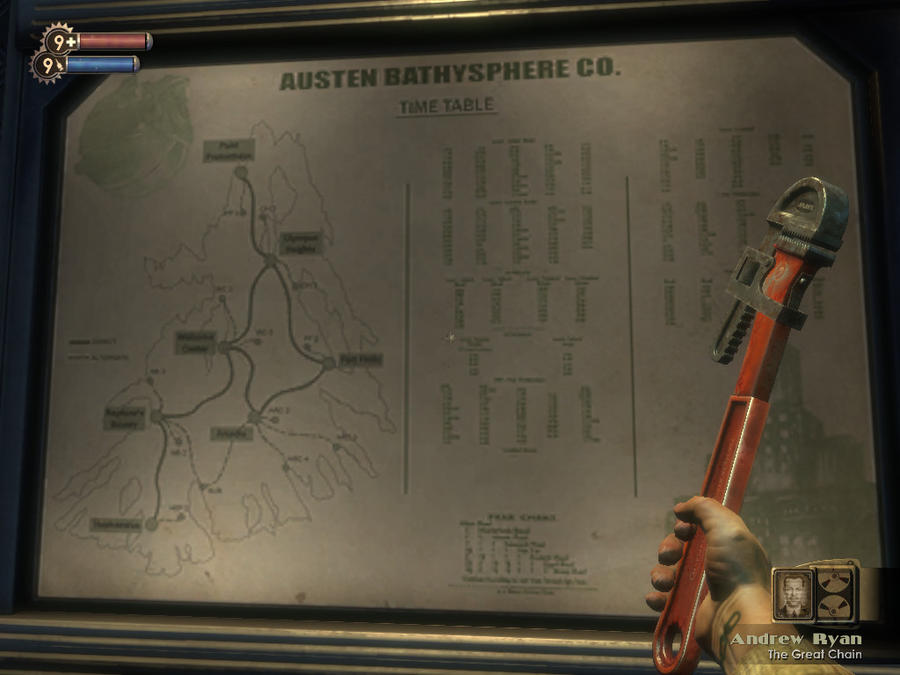If you wish to become a video game designer, it is wise to learn as much as possible about the field, but do not forget other mediums. Innovation is a vital element of the gaming industry and one of the keys for developing novel concepts is looking for inspiration where no one else is.
You can have your “eureka moment” and think of a new technique when watching a scene from a movie, reading a description in a novel or walking through an amusement park.
When it comes down to parks, Walt Disney World is the dream destination of most people around the globe, as it occupies the number one spot on the list of most visited theme parks on Earth, according to the website World Atlas.
This popularity did not happen without a reason. The experiences in the park are carefully constructed to push the human imagination to its limit and aiming to keep the Disney standard of quality in the park, the company developed a list known as Mickey’s Ten Commandments.
This is a set of rules Disney uses when creating new attractions to the park, but it can also prove valuable to an aspiring video game developer, as parks and game design have a lot more in common than you may think.
Mickey’s Ten Commandments are:
 1- Know your audience;
1- Know your audience;
2- Wear your guests shoes;
3- Organize the flow of people and ideas;
4- Create a weenie (visual magnet);
5- Communicate with visual literacy;
6- Avoid overload;
7- Tell one story at a time;
8- Avoid contradiction;
9- For every once of treatment, provide a ton of fun;
10- Keep it up!
In this article, we will explain each one of these rules and address how designers can apply them to design better games, but before talking about Mickey’s Ten Commandments and their use in gaming, let’s discuss one core similarity between designing a park and a video game.
It is all about the experience:

Released in 2013 by Irrational Games and 2K, BioShock Infinite is a First Person Shooter that allowed players to be in the shoes of Booker DeWitt, a former solider who received the mission of travelling to the floating city of Columbia to rescue Elizabeth, a girl who spent her life incarcerated in a tower due to her ability to open doors to parallel universes.
The universe of BioShock Infinite (above) carries many references to Walt Disney World, from the art, to the design of the areas, where each one carried a specific theme, as in a Disney park.
The most important aspect to observe in this game; however, is that whilst its core gameplay mechanic consists of shooting enemies, the experience is larger than that.
As players walk through the streets of the city, they explore the area and uncover its secrets and pay attention to the slightest detail of the carefully crafted world, as they interact with its characters.
This occurs for a reason — suspension of disbelief.

This is a basic technique of entertainment, which consists of making the audience accept the premises of a work of fiction, even if they are absurd in real life. The idea is to allow players to forget about the logic of the real world and immerse themselves in a fictional universe.
In order to “sell” the idea of a floating city in BioShock Infinite, developers created a set of rules through the story of the game and crafted every section of the experience accordingly, from the art style, to the soundtrack.
It is crucial that every aspect of the production communicates the same vision. A poorly placed element could break the immersion and ruin the experience of the player.
With this being said, BioShock Infinite is a shooter, but its success occurred due to the sum of its parts. Audio, art style, characters and many more elements that, when put together, created a whole experience.

Now, regarding Walt Disney World…
The central point of Disney, and any theme park, are the rides, but they alone cannot sustain the success the park has had. People do not go to Disney to ride a roller coaster, they go there, in order to explore the park and enjoy the experience as whole, to the finest details that compose the magic universe of Walt Disney World.
Just as BioShock Infinite is a shooter, but people do not play it solely for the shooting, Disney is a park, but people do not go there simply for the rides. In both cases, what people wish for is the whole experience.
The whole experience is what makes a game successful, not only its basic mechanics.
The whole experience is what made Disney successful, not only its rides.
This is the connection of game design and Walt Disney World. Their success depend on carefully crafted experiences, which need several fragments to come together and become an united piece.
This is a crucial lesson any aspiring designers needs to learn. A game is a lot more than just its gameplay.
With this said, it is time to analyze with more detail how Disney builds its parks and how these lessons apply to game design. In order to do this, we will take a look at the aforementioned Mickey’s Ten Commandments.

1- Know your audience:
“Identify the prime audience for your attraction or show before you begin design.”
In any commercial endeavor, it is crucial to determine who your target audience is. Any aspiring designer must understand that he may have to develop a game for an audience he is not found within.
If that is the case, it is paramount to discover the preferences of the target demographic, in order to determine the direction of the project.
This brief intro takes us to the next topic.

2- Wear your Guests’ shoes:
“Insist that your team members experience your creation just the way Guests do.”
In this case, we should change “guests” for “players.”
This second Mickey Commandment claims that a creator of a experience, as well as the people behind it, should see his work through the lenses of the audience. This is boils down to a single word: empathy.
The Marrian-Webster dictionary defines empathy as:
“The action of understanding, being aware of, being sensitive to, and vicariously experiencing the feelings, thoughts, and experience of another of either the past or present without having the feelings, thoughts, and experience fully communicated in an objectively explicit manner”
This skill is fundamental, because the designer needs to create a product that suits the taste of the target audience and if the designer is not inserted in this demographic, he/she may need to develop a game that is not fun for himself/herself.
In order to clarify this idea, let’s see an example:
Imagine a 30 years old man, who needs to develop a game for a target audience that consists of teenage girls. The dissonance between the tastes of the designer and of his target demographic will make it hard for him to create a successful game, unless he develops empathy and starts to look at his design through the eyes of a teenage girl.
This is a tricky feat to achieve and in order to do so, the designer must know as much as possible about the players. Luckily, the field of psychology has some tools to make the life of a game designer easier in this regard.
One of them is the Myers-Briggs Type Indicator and the Wikipedia entry explains what it is:
“It is an introspective self-report questionnaire designed to indicate psychological preferences in how people perceive the world and make decisions.”
Once the volunteer answers all of the questions, a report is generated, which gives an overall look at a person’s psyche, as the image below shows:
The video below shows the YouTube channel The Game Theorists using this test to analyze the personality of its audience, in order to determine the reason why players had certain preferences in the choice-based game Life is Strange.
[Warning: Spoilers for Life is Strange]
After applying this test to several people who represent the target audience, a game designer will have a solid idea of what to aim for when designing the game, thus develop empathy.
So, now you have the tools to know the drives of your target audience. What comes next? Mickey’s Third Commandment tells us.

3- Organize the flow of people and ideas:
“Make sure there is a logic and sequence in our stories and the way Guests experience them.”
In Disneyland, each area of the park tells a different story, but the designers of the park ensured to expose each narrative in a concise way.
In video game design, this Commandment is mostly associated with open world games, through the way the development team places the various points of the world in the map.
Take for example the world of Fallout 4 (below).

Each one of these locations tells to the player a bit about the story of the game, but it is important to know where to position these places. The game must deliver the story in a concise, logical and sequential order, otherwise the player may become confused and lose the interest in the narrative.
To prevent this from happening, the developers must take into account two factors — the player’s starting point in the world and the game mechanic known as “fast travel.”
Have you ever wondered why in most games you can only fast travel to a location after you have traveled there for the first time? There are plenty of reasons, but one of them to is to ensure that the player will follow the background story in a logical order.
In most open world games, which parts of the story a location tells is based on how far from the player’s starting point this place is. With this said, if a player walks closely to the starting point, regardless of the direction, he/she will only uncover simple details of the story, while the game reserves more in-depth information for areas further away.
If the game grants to the player the ability to fast travel to a location, without progressing through the game to arrive in it, it will risk breaking the narrative, as players will discover elements of the story out of sequential order.
With this said, as Mickey’s Third Commandment states, it is paramount that a game designer creates an experience that tells a story in a concise way, even if it is fragmented, as in a Disney park.

4 – Create a wienie (visual magnet):
“Create visual ‘targets’ that will lead Guests clearly and logically through your facility.”
In a park, it is important to add visual clues indicating where to go next and so is in gaming. Players need to understand clearly where to go, in order to proceed with the plot, but adding an element to act as “visual magnet” can be tricky.
As stated herein, the game designer must sell the “plausibility” of the fiction, in order to suspend the disbelief of players and allow them to immerse themselves in the game.
If you add a visual element to guide players, but it does not mix with the rest of the universe, you will break the immersion, as the visual magnet will be perceived by players as a foreign element.
An example of visual magnets being well implemented in a game is Journey, where developers added a mountain with a light beam coming from its top. Most importantly, through the art of the game, this visual element matches with the surroundings of the player, thus feeling natural and maintaining the suspension of disbelief.
A game which received mixed reactions regarding its use visual magnets was Splinter Cell: Conviction (below).

The game used text projected on objects and walls to tell to the player where to go. These had the intention of showing to players the thoughts of Sam Fisher, the protagonist.
A poll on Ubisoft’s official forum asked whether players wanted to have the option to remove these projections from the game. The results showed a perfect split. As we see in the comment from this poll, some users felt that the projected texts were intrusive and hurt the immersion of the gameplay.
This brings us to an important conclusion — when designing visual magnets, it is a safer bet to use objects that are already part of the universe, as the mountain of Journey, so they do not stand out in a negative way, appearing as foreign elements, as the texts of Splinter Cell: Conviction.
This connects with the next Commandment from Mickey Mouse.

5- Communicate with visual literacy:
“Make good use of color, shape form, texture – all the nonverbal ways of communication.”
“Always show, do not tell,” is a basic rule of any medium that delivers a story and it has more importance in video game than in any other form of storytelling.
According to the video below from the YouTube channel Extra Credits, one hour-long television shows have approximately 20-30 minutes of dialogue, whereas in video games, this figure drops to ten.
This occurs due to the interactive nature of games. They allow their audience to explore the environment and receive information regarding the plot by observing the world around them, as opposed to relying on an exposition done by a character.
This reduces the number of words spoken in a game, but places greater emphasis on what is known as “environmental storytelling” — telling a story through the world.
A game that mastered this type of narrative is BioShock (below).

In it, players survive as they explore the fallen underwater utopia of Rapture. The image above shows how the game uses visuals to tell portions of the story.
In this point of the game, no character has told to the protagonist when this society met its demise, but through the art of the world, players know that it happened during New Year’s Eve of 1959.
This is just one example of tens, if not hundreds, of opportunities where the development team found a way to send a message to the player through the art of the game.

6- Avoid overload – create turn-ons
“Resist the temptation to overload your audience with too much information and too many objects.”
You can tell a story through the environment, but it is important to avoid filling the world of the game with an overabundance of objects and information, otherwise you may confuse the player with an overwhelming amount of messages and visual pollution.
To achieve this goal, we can rely on a rule from film making, which states that every object that appears on screen must have relevance to either the story or to the development of the character.
This concept provides us with a solid idea when designing environments for a game. As an aspiring game designer, when creating your levels, you must discover which objects and visual guides are essential to the player, in regards to both combat and environmental storytelling.
If you add too many objects to a room, not only the will distract the player, but they will consume resources from the team, as additional time will be required to create them. In the end, everybody loses.
Keep it simple, but you should also avoid placing too few objects and make the world lose its life. Finding the right balance can be tricky and concept arts are usually the most useful tool to use in this case.

The world of Mirror’s Edge is an example of a game that only has enough objects in the area to build the suspension of disbelief and allow players to navigate through the level in a challenging way, as seen in the image above.
Which brings us to the next topic…

7 – Tell one story at a time:
“If you have a lot of information divide it into distinct, logical, organized stories, people can absorb and retain information more clearly if the path to the next concept is clear and logical.”
As previously stated herein, in a Disney park, visitors walk through different areas and each one of them have a different theme and mostly importantly, they all tell a different story.
The 7th Commandment of Mickey Mouse exists in order to ensure the audience understands the message being delivered in a concise way. To do this, it is crucial that all of the areas in the park tell a different story, but all of them connect somehow to create a larger narrative arc.
This same principle applies to game design, and to discuss a stellar example of this concept in practice, we will take a look at BioShock once again.
In The 5th Commandment of Mickey, we addressed the concept of environmental storytelling and its use in this production. In order to understand how the rule of “tell one story at time” fits in this game, we first need to answer why it relies heavily on environmental storytelling. It is all about the narrative structure of the game.
The most common type of story consists of three acts:
Act I – Introduction to the characters and the universe of the story. It ends once the conflict of the plot starts.
Act II – The quest of the protagonist to resolve the main conflict of the narrative. Ends with the climax.
Act III – A brief glimpse of how the characters and/or the universe changed after the conflict has been resolved.
This structure is mostly used in literature and films, but in video games, it changes a bit. Given that the selling point of video games is their interactive nature, developers try to put the player in the middle of the conflict as soon as possible.
For this purpose, they often use a literary device known as “in medias res”, which means “in the middle of things”. This concept consists of starting the story on Act II, in the middle of the main conflict, and BioShock made a masterful use of this technique by dropping the player in the middle of the conflict for the control of Rapture.
“But how did developers introduced players to the characters and the conflict erupting in Rapture without the first act?” You may ask.
This is where environmental storytelling comes into play.
Through the art of the fallen society of Rapture, players can get glimpses of how life once was in that city and through constructions, posters and propaganda, the audience can understand the events that led to the downfall of the city, thus delivering the information of Act I, while players explore Act II.
The story of Rapture; however, is very complex, to the point it was turned into the novel BioShock Rapture, written by John Shirley, so delivering this amount of information through the visuals of the game is not an easy task.

The story of BioShock consists of the player traveling through key areas of the city of Rapture (above) and each one of these locations tell a mini-story. The player reaches the area, but some event prevents the audience from moving to the next level. Players then need to complete certain tasks to overcome these obstacles and continue to the next part of town.
This is how BioShock managed to deliver a complex story in an understandable way. It broke down the story of the city into smaller narratives and delivered them to players one at a time — one level at a time.

8 – Avoid Contradictions:
“Clear institutional identity helps give you the competitive edge. Public needs to know who you are and what differentiates you from other institutions they may have seen.”
Every major video game franchise has an element that identifies it, regardless of that being a character, the art style, a gameplay mechanic of a combination of each of these factors.
The problem; however, is that as more installments of the series are developed, it can become difficult to maintain the identity of the franchise — the reason why it became popular.
A series need to change over time, in order to keep its fans engaged, but this movement needs to be planned carefully. If the change contradicts one of the essences of the franchise, the fans will not be pleased with the result.
A prime example of how the lack of consistence can hurt a series is the latest installment in the Call of Duty franchise, Infinite Warfare, which sold approximately 50% less than its predecessor.
With the franchise moving away from its military roots to pursue shootings in outer space, it lost its identity and the interest of its fans in the process. This is a clear example of what NOT to do when aiming to deliver some change to a franchise.

9 – For every ounce of treatment, provide a ton of fun
“How do you woo people from all other temptations? Give people plenty of opportunity to enjoy themselves by emphasizing ways that let people participate in the experience and by making your environment rich and appealing to all senses.”
This Commandment from the world’s most beloved mouse stands for the autonomy visitors have in Disneyland. They can go to the rides, visit the areas and watch the shows in any order they wish and through all of the techniques created above, Disney created an alternative reality, via its parks, which provide a rich experience to all of the senses of a person. Even the smell of popcorn is added to some areas where visitors will watch a show, in order to explore people’s senses to their fullest.
The most important aspect to observe here is the autonomy visitors have and how they can still enjoy the experience regardless of how they choose to spend their time in the park.
This is similar to the premise of GTA V, a game that allows players to explore an open world in any way they want and this is one of the reasons for its success. Through the autonomy it allows players to have when deciding what to do in the game, it pleases a broad audience.
This is a lesson every aspiring designer must have in mind. Of course, not every project has neither the scope nor the budget of GTA V, but it is important to allow players to have some autonomy on how they tackle the situations within the game. This not only adds depth to the gameplay, but also broadens the target audience of the project, thus making it more profitable.

10 – Keep it up!
“Never underestimate the importance of cleanliness and routine maintenance, people expect to get a good show every time, people will comment more on broken and dirty stuff.”
Everything in a Disney park is built aiming for perfection, even maintenance and cleaning duty, as Disney strives to deliver to visitors the absolute best experience they possibly can. If you are an aspiring video game designer, this is the mindset you should follow.
Of course, it is impossible to be perfect, especially in the video game industry with the budget and schedule constraints teams operate under, but that should not stop you from trying anyways. When you do what you love, there is no excuse to not dedicate a 100% of yourself to delivering the best game you possibly can.
Do not use the circumstances as an excuse for delivering an underwhelming game, because players will only care for the quality of the final product, not the circumstances under which it was created.
Conclusion
These commandments developed by Disney have withstand the testament of time and are still relevant today, as Walt Disney World continues to be the most popular theme park in the world.
I made my best to summarize the applications of these rules in game design, but this is a complex topic and if you wish to know more details about the reasoning behind the art of crafting experiences at Disney, I recommend the book One Little Spark, which you can purchase for 14 dollars on Amazon.
Of course, these are only some guidelines you should follow when designing your game, but they show that making the right connections, it is possible to link two subjects that seem unrelated to each other.
So, next time your are watching a film, reading a book or walking through a theme park, remember to keep an eye on the small details, as it is always possible to learn from other forms of art.
As Steve Jobs said, innovation is all about “connecting the dots.”










Published: Jan 19, 2017 09:20 am